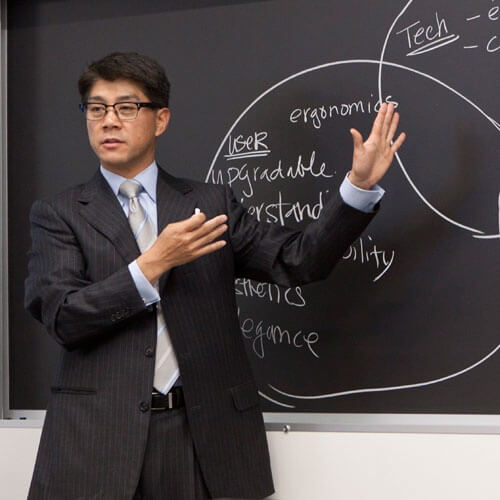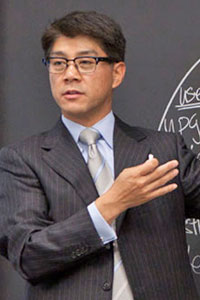News
Any design solution will involve technical constraints, business constraints, and user constraints, explained Prof. Woodward Yang. The best design will satisfy all three. (Photo by Eliza Grinnell, SEAS Communications.)
Participants in the workshop offered definitions for the term "design," settling on "the process of observing a problem in the world and finding a solution." (Photo by Eliza Grinnell, SEAS Communications.)
Seven years ago, the PBS series Frontline World profiled American philanthropist Trevor Field, who was trying to assist with water scarcity in rural South Africa. Field and his collaborators introduced a new type of pump: one that was operated by a playground roundabout and which stored clean water in a large tank that was covered in billboards to pay for its maintenance. As a result, children received a new place to play, and the whole village gained access to clean, fresh water on demand.
Woodward Yang, Gordon McKay Professor of Electrical Engineering and Computer Science, played the Frontline video clip at a Design Solutions Workshop hosted by the School of Engineering and Applied Sciences (SEAS) on May 3.
“How many of you think that was a good design?” he asked his audience at the end of the clip.
Almost every hand in the room shot up.
Yang then played a second video. The Frontline producers had returned to South Africa 5 years later and found numerous problems with the play pumps: the tanks were no longer holding water; older women were unable to operate the equipment; there was no money for maintenance; and children were fighting in the playground.
“How many of you still think it was a good design?” Yang asked.
The videos set a tone of both ambition and humility for the workshop, which emphasized the importance of comprehensive planning, cultural awareness, and a holistic approach to design in the solution of global problems. Equally applicable to students of government, environmental science, and business, the 5-hour event wove together lessons in teamwork, public speaking, careful observation, human dynamics, and critical thinking—along with a good dose of fun.
The Design Solutions Workshop was intended to help the participants develop a structured process through which they could direct their creativity toward solving a carefully formulated problem. Through lively, hands-on design activities, approximately 50 participants learned how to “empathize, synthesize, ideate, prototype, and test,” step by step.
The structured process helps designers to avoid the pitfalls and mistaken assumptions that can doom a project, explained Jackie Stenson ’08, a Preceptor in Technology Entrepreneurship and Innovation at SEAS who led the hands-on portion of the workshop. (Stenson is also a co-founder of Essmart Global, which is one of the finalists in the 2012 President’s Challenge.)
“It’s easy to, for example, skip ‘empathize’ and go straight into ‘design,’ which is what a lot of people do,” she said. “They define a problem without really understanding what the user needs are.”
Kelvin Kwong, an MBA candidate, works with Erin Henry, a PhD student in organizational behavior, to brainstorm design solutions. (Photo by Eliza Grinnell, SEAS Communications.)
Participants in the Design Solutions Workshop were a diverse group, including undergraduates from a wide range of concentrations, graduate students and MBA candidates, University employees, venture capitalists, engineers, and even local real estate professionals. It was an appropriately multitalented group, said Yang, because generating a viable solution to any problem requires a deep level of understanding in three areas: technical issues, business issues, and user issues.
“It’s very difficult for one person to have all that expertise,” he said.
To emphasize the value of teamwork, Stenson and Yang engaged the participants in a creative activity in groups of four or five and tasked each group with designing a product that would improve the experience of attending a party—a trivial scenario, but still challenging for a short workshop.
The exercise forced the participants to engage with each step of the design process in turn. Each group spent time observing social interactions, discussing what they saw, brainstorming, developing a solution, and then soliciting feedback. By the end of the workshop, each team had not just a solid idea for a product, but also a carefully crafted pitch.
A team of students storyboards a user interface for an app that helps people to make friends. (Photo by Eliza Grinnell, SEAS Communications.)
Around the room, students were beginning to relate the experience to their own interests and ambitions.
Burhan Saif Addin, a visiting graduate student from Saudi Arabia, was looking forward to applying design principles to his research in applied physics, which involves developing new materials for solar cells.
“There are more than a billion people who do not have access to electricity in the world, and if we had inexpensive solar cells, we could bring them to the modern world,” he said. “They would have electricity and access to computing and health services and communication.”
The problem, he said, is clear, but the solution requires both technical knowledge and an awareness of the context in which it would operate.
“What would be the best design for a solar cell model?” he asked. “You couldn’t just use the same design that you have on rooftops. It wouldn’t be the best design for rural areas. Would you put it on a plastic substrate or an aluminum substrate? How can you optimize its angle toward the sun?”
The technical challenges are complex, but the socioeconomic aspects are too.
“It’s important that we train students to advance science in their narrow area, but it’s also important for them to understand how to look at problems broadly, how to work with other people, and how to actually solve problems that are pressing in the world,” said Fawwaz Habbal, Executive Dean for Education and Research at SEAS.
Zamyla Chan ’14 saw the workshop as a bridge between her interests in environmental engineering and entrepreneurship.
“Especially with environmental products, I find that when people try to show a new, innovative product that’s supposed to be super green, sometimes it doesn’t take off because people say, ‘It’s too new, I don’t know how to use it, and it’s inconvenient,’” Chan explained.
By learning more about the design process, Chan added, she hoped “to get a sense of how one might be able to develop a product that is sustainable as well as marketable—something that would actually catch on.”
An engineering sciences concentrator, Chan participates in Engineers Without Borders at Harvard, an international organization whose members learn to balance the capabilities of engineering with the needs of a given community.
The phrase “engineers without borders” might also fittingly describe the type of students SEAS hopes to produce by expanding the role of these interdisciplinary design activities in the curriculum.
"This type of design thinking is extremely important for all Harvard students," said Yang. "We are fortunate to have brilliant people working in so many different fields, and it's important that we continue to find ways to bring them together and provide them with a practical framework for solving problems for the world."
Cutting-edge science delivered direct to your inbox.
Join the Harvard SEAS mailing list.
Scientist Profiles
Woodward Yang
Gordon McKay Professor of Electrical Engineering and Computer Science

